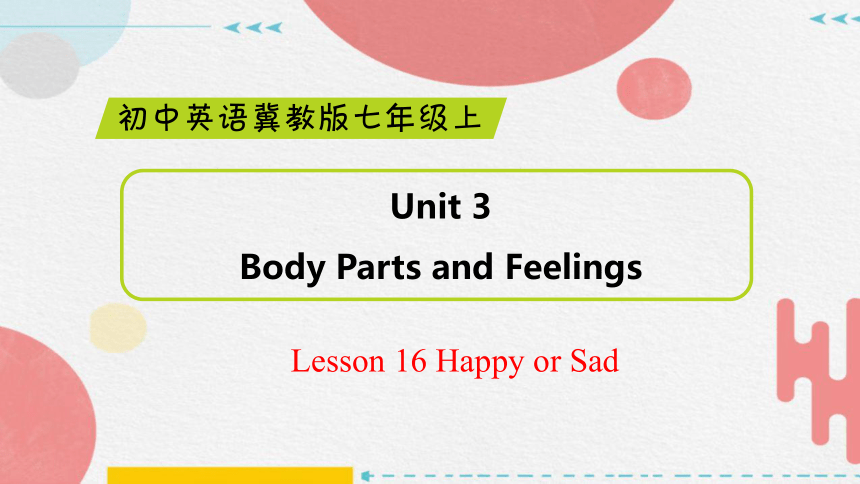(
课件网) Unit 3 Body Parts and Feelings 初中英语冀教版七年级上 Lesson 16 Happy or Sad 1. 掌握重点单词:(预习中掌握 :hurt, donut, enough, laugh) 2. 用英语描述询问对方的心情。 (1) How do you feel today (2) Don't be so sad. (3) Are you tired (4) My mum wants me to eat just one donut a day. 【教学重点】学习用英语描述自己的心情并询问对方的心情。 Are you happy or sad Lead in Ask and answer these questions with your partner. Learn the new words and expressions. Learn oh hurt donut enough laugh int. 哦 adj. 痛的;受伤的 v. 伤害;疼痛 n. 面包圈 adj.&adv. 足够的(地) v. 笑 Jenny:Hi,Danny!I feel happy!How do you feel today? Danny:I'm NOT happy. Jenny:Oh!What's wrong?Are you hurt? Danny:No,I'm not. Jenny:Are you tired? Danny:No,I'm not. I feel sad. My mum wants me to eat just one donut a day. Jenny:Oh,Danny. Don't be sad. Your mum is right. One donut a day is enough. Learn the lesson. Learn 1 How do you feel? Fill in the blanks. Practice Jenny: Hi, Danny! I feel _____! How do you feel today Danny: I’m NOT _____, thanks. Jenny: Oh! What’s _____ Are you _____ Danny: No, I’m not. Jenny: Are you _____ Danny: No, I’m not. I feel _____. My mum wants me to eat just one _____ a day. Jenny: Oh, Danny. Don’t be sad. Your mum is right. One donut a day is _____. happy happy wrong hurt tired sad donut enough We all have feelings. Yes, we do! We all feel happy and sad, too. Sometimes we laugh. Sometimes we cry. Sometimes we're down. Sometimes we're high. Learn the lesson. Learn 2 We all have feelings. In English,you can use the words down and high to describe direction and height,like go down the street and the kite is high in the sky. But you can also use these words to describe feelings. To feel down means to feel sad. To feel high means to feel happy. Culture Tip down and high 知识讲解 1. How do you feel?你感觉怎么样? 该句是how引导的特殊疑问句,其结构为:“How+助动词+主语+feel?”。常用来询问他人的身体状况和感觉,其答语通常为“主语(+don't/doesn't)+feel+形容词.”或“主语+be(+not)+形容词.” eg:—How do you feel today? 你今天感觉怎么样? —I feel happy. 我很开心。 知识讲解 2. I'm NOT happy. 我不高兴。 此句用来回答问感觉的特殊疑问句。此处的NOT用来表示强调。单词happy意为“高兴的,快乐的,幸福的”。 eg:It is NOT a blackboard. It's a whiteboard. 它不是一块黑板。它是一块白板。 知识讲解 3. What's wrong?怎么啦? (1) 该句常用于询问别人的身体状况,也是医护人员询问病人病情时的常用语。其同义句是“What's the matter?/What's the trouble?/What's one's trouble?”,后面接人时,需用介词with。 eg:—What’s wrong with you? 你怎么啦? —I have a headache. 我头痛。 (2) “What's wrong/the matter?”还可用于询问某物出了什么毛病,或者某人遇到了什么不顺心的事。 eg:—What’s wrong/the matter with the clock?这个钟出什么问题了? —It doesn't work. 它坏了。 拓展 What’s wrong(with)...? 与What’s the matter/trouble(with)...?同义; 后接“人”时可用What's one's trouble?替换。 eg:What's ... ...

